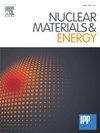Improved Coulomb collision operator for kinetic ion transport with EMC3-EIRENE simulating Nitrogen seeding in medium density ITER L-mode scenario
IF 2.7
2区 物理与天体物理
Q1 NUCLEAR SCIENCE & TECHNOLOGY
引用次数: 0
Abstract
Previous simulations with the kinetic ion transport module of EMC3-EIRENE for Nitrogen seeding in a medium density ITER L-mode scenario showed that the currently simplified Coulomb collision model of EIRENE leads to a strongly overestimated confinement of the kinetic ions in the magnetic mirror regions. This simplified Coulomb collision model in EIRENE is based on an energy relaxation time only and is not changing the ratio of the parallel and perpendicular velocity components for the kinetic ions and thus does not include any scattering of the kinetic ions into the loss cone of the magnetic mirror. We have now implemented a new Coulomb collision operator in EIRENE, where the Coulomb collisions are described by a linear kinetic equation in Fokker-Planck form utilizing the Trubnikov-Rosenbluth potential functions, which includes scattering of the kinetic ions as well as friction with the background plasma. The Fokker-Planck equation is treated by an operator splitting scheme and is solved locally by a Monte-Carlo method. The choice of a small enough time step in the Monte-Carlo integration method is crucial and depends strongly on the local plasma background. Two methods to locally adapt the Monte-Carlo integration time step were implemented. One uses simply a fraction (∼10–4) of the local Spitzer slowing down time and the other applies an adaptive time step control with error estimation. It turns out that simulations using the adaptive time step control method are up to a factor 10 faster compared to the time step control using the Spitzer slowing down time. In this work we will present the details of this newly implemented Coulomb collision operator for kinetic ions in EMC3-EIRENE and the implementation of the adaptive time step algorithm. We applied this new Coulomb collision operator in a kinetic ion simulation with EMC3-EIRENE for Nitrogen seeding, where we puffed Nitrogen from the top of the machine in an attached medium density ITER L-mode scenario (nsep = 1×1019 m−3, Psep = 20 MW). This shows that the unphysical and exaggerated confinement of the kinetic ions in the magnetic mirror regions observed with the simplified Coulomb collision model in EIRENE is now resolved with the new Coulomb collision operator, which treats the scattering of the kinetic ions into the loss cone of the magnetic mirror correctly.
基于EMC3-EIRENE的改进库仑碰撞算符模拟中密度ITER l模式下氮种子的动态离子输运
之前利用 EMC3-EIRENE 的动能离子传输模块对中密度热核实验堆 L 模式方案中的氮气种子进行的模拟表明,EIRENE 目前简化的库仑碰撞模型导致动能离子在磁镜区域的束缚被严重高估。EIRENE 中的简化库仑碰撞模型仅以能量弛豫时间为基础,并没有改变动能离子平行和垂直速度分量的比率,因此不包括动能离子散射到磁镜损耗锥的情况。现在,我们在 EIRENE 中实施了一种新的库仑碰撞算子,利用特鲁布尼科夫-罗森布洛特势函数,用福克-普朗克形式的线性动力学方程来描述库仑碰撞,其中包括动能离子的散射以及与背景等离子体的摩擦。福克-普朗克方程采用算子分裂方案处理,并通过蒙特卡洛方法进行局部求解。在蒙特卡洛积分法中,选择足够小的时间步长至关重要,并且在很大程度上取决于当地的等离子体背景。我们采用了两种方法来局部调整蒙特卡洛积分时间步长。一种是简单地使用当地斯皮策减速时间的一部分(∼10-4),另一种是使用误差估计的自适应时间步长控制。结果表明,与使用斯皮策减速时间的时间步长控制相比,使用自适应时间步长控制方法的模拟速度最多可提高 10 倍。在这项工作中,我们将详细介绍在 EMC3-EIRENE 中为动力学离子新实施的库仑碰撞算子以及自适应时间步长算法的实施。我们将这一新的库仑碰撞算子应用于 EMC3-EIRENE 的氮气播种动能离子模拟中,在中密度 ITER L 模式场景(nsep = 1×1019 m-3,Psep = 20 MW)中,我们从机器顶部喷入氮气。这表明,在 EIRENE 中的简化库仑碰撞模型中观察到的磁镜区域动能离子的非物理和夸大限制,现在通过新的库仑碰撞算子得到了解决,新算子正确处理了动能离子散射到磁镜损耗锥的问题。
本文章由计算机程序翻译,如有差异,请以英文原文为准。
求助全文
约1分钟内获得全文
求助全文
来源期刊

Nuclear Materials and Energy
Materials Science-Materials Science (miscellaneous)
CiteScore
3.70
自引率
15.40%
发文量
175
审稿时长
20 weeks
期刊介绍:
The open-access journal Nuclear Materials and Energy is devoted to the growing field of research for material application in the production of nuclear energy. Nuclear Materials and Energy publishes original research articles of up to 6 pages in length.
 求助内容:
求助内容: 应助结果提醒方式:
应助结果提醒方式:


